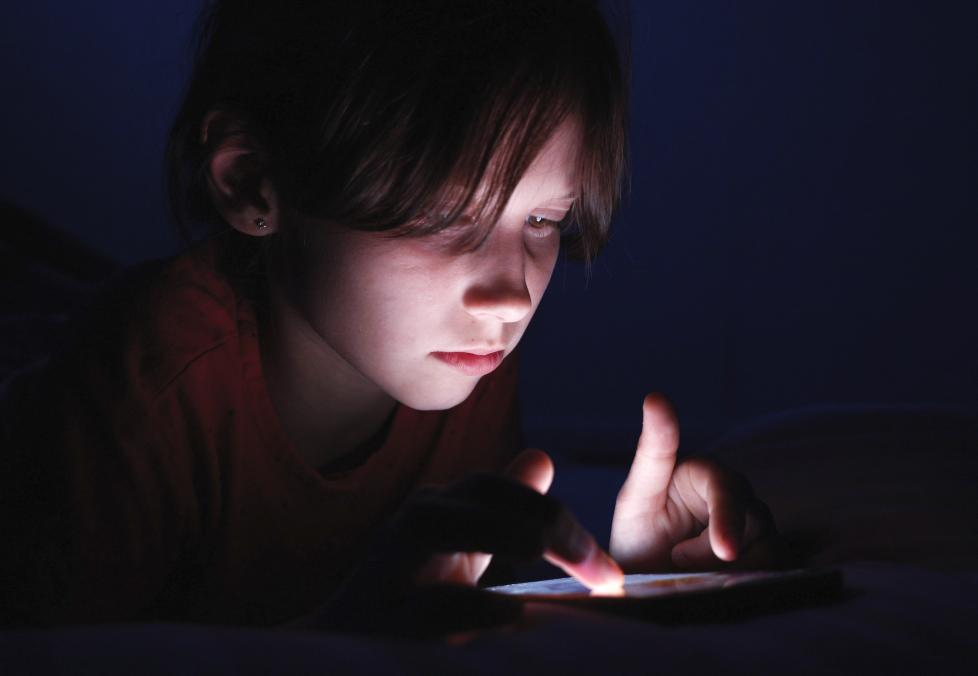
Two pairs and a free, quality eye exam for just $79.95
Everything you need to know to take care of your eyes — for life.
What you need to know about the ways your screen time is impacting your vision.

People have been focusing on blue light a lot lately.
Just look around. The use of electronic devices is startling, and it raises the question: Just how bad is all that blue light for your eyes?
Turns out, we’re still in the dark about that.
Blue light—the high-energy kind put out by the sun (the largest blue-light source), fluorescent and LED lights, and digital screens—is troubling because it has more energy than other colors in the visible spectrum. In high doses, it’s likely to damage cells.
What’s more, unlike lower-energy forms of light, blue light can wiggle its way through your cornea and lens, gaining direct access to (and possibly damaging) your retina. (That’s the all-important part of the eye that sends signals to your brain, telling it what to see.) This may explain why some studies have linked blue-light exposure to long-term damage in your eyes.
“I’m seeing eye strain, cataracts, and macular degeneration in much younger populations than I used to,” says Margaret Barrett Harrington, O.D., an optometrist for 22 years who works at America’s Best Contacts & Eyeglasses in Daytona Beach, Fla. “I think blue light from devices is at least contributing to that.”
Indeed, with the rise of smartphones, tablets, and laptops, our exposure to blue light has reached remarkable levels, especially at night. This can throw off your biological clock and get in the way of a good night’s sleep. But it may be years before other potentially harmful effects become known.
Here are a few of the top questions patients have about blue light and their eyes, answered.
Here’s what we do know: Staring at digital screens all day can seriously strain your eyes, according to the American Academy of Ophthalmology. And because these devices give off blue light, they have been associated with eyestrain, though the role blue light plays (if any) is not clear.
One possibility: Because blue-light waves scatter more throughout the eye, they may create more “visual noise,” reducing contrast and contributing to eyestrain.
According to the Vision Council, more than half of American adults suffer adverse effects from overexposure to screens, including eyestrain, blurred vision, and dry eyes.
Dr. Harrington says she sees patients suffering from these symptoms “every single day.”
Your eyes work harder to focus on objects close up, she says, so staring at screens for hours without breaks can tire them. That’s why eye doctors are always pushing the 20-20-20 rule: Every 20 minutes, look 20 feet away for 20 seconds.
“We evolved as hunters,” Dr. Harrington says. “Our eyes evolved to see far away. Now we’re changing that. We’re spending 12 hours at 20 inches a day, and our eyes are constantly engaged to keep focus. That contributes to fatigue, because our eye muscles weren’t made to do that.”
Staring at close tasks may also cause you to blink less often than you should, drying out the thin protective layer of lubrication that covers the eye—which can lead to dry, irritated eyes.

Two pairs and a free, quality eye exam for just $79.95
First, increasing evidence suggests blue-light exposure at night can curb melatonin and mess with your biological clock (or your circadian rhythm), impacting sleep quality. (Some research even shows that a shift in the timing of a person’s circadian rhythm may have a connection to cancer, diabetes, heart disease, and obesity.)
In addition, looking at a bright screen in a dark room can be especially straining on the eyes, Dr. Harrington says. The stark difference in the two light sources, she explains, forces your eyes to work particularly hard—when what they should be doing is powering down to reset for the next day.
“The last thing many people do before sleep is look at their phone,” she says. In fact, nearly 80% of Americans admit to using digital devices in the hour before they go to sleep, according to the Vision Council. “That has an even greater effect on the retina.”
If you must check your phone or computer at night, make sure the surrounding lighting is good, Dr. Harrington says. Try dimming overhead lights to cut down on the screen glare, and adjust the contrast level on the screen itself so it’s more comfortable for your eyes. You can also switch your smartphone to night mode, which reduces some of the blue light.
Some evidence suggests that extended overexposure to blue light can damage the retina. No surprise, when the retina isn’t functioning properly, Dr. Harrington says, you’re at a greater risk for eye diseases like cataracts (clouding of the eye’s lens) and macular degeneration (which pokes away at your central field of vision and is a leading cause of vision loss).
A 2018 study from the University of Toledo revealed a possible mechanism: When blue light interacts with retinal (a key molecule for vision), it appears to trigger cell death, possibly destroying photoreceptor cells in the eyes.
However, it’s important to note that the cells that were tested were made in the lab, not derived from living eye tissue. Plus, the effect was evident only at greater energies than what’s emitted in a real-world scenario by a typical consumer-electronic device.
Bottom line: The science is still evolving, so it’s tough to make a definitive cause-and-effect statement.
When you add a blue-blocker coating to your lenses, they’re baked with a solution that filters out some of the blue light. The new NeverBlue lenses from America’s Best reduce blue-light exposure by 20%. (For comparison, a standard clear polycarbonate lens blocks just 5% of blue light.)
It’s still too early to say whether that will aid eye health or reduce symptoms of eyestrain, but it certainly can’t hurt, says Dr. Harrington.
She points out that in her experience, many people feel relief from eyestrain symptoms after switching to antireflective lenses, which can help reduce glare from a computer screen. She suspects that new blue-blocking lenses will help even more.
“Most of the products are relatively new,” Dr. Harrington says, “but I would say in the next few years, we’ll start getting some feedback.”
And unlike other preventive tips (like shutting down digital devices at night or taking frequent breaks), the glasses don’t require you to alter your routine, she says.
“I doubt people are going to change their habits,” she says. “That’s just the way our world is going. So I think things like blue-blocking lenses will help them not be so tired and bothered at the end of their long days.”
Plus, a growing body of research suggests that wearing blue-blocking glasses at night can improve sleep quality. In one small study reported in the Journal of Adolescent Health, 13 screen-happy teenagers felt “significantly” sleepier on nights they wore blue blockers.
In another study, 20 adults who wore amber-tinted lenses (which also block blue light) saw sleep quality improve significantly after two weeks. The adults’ moods also took a turn for the better.
In addition to blue-light blockers, Dr. Harrington also recommends adding an anti-reflective coating and UV protection. And if you wear contacts, you can get blue-blocking glasses without a prescription.